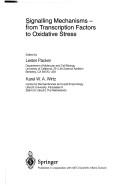| Listing 1 - 10 of 46 | << page >> |
Sort by
|
Dissertation
Year: 2024 Publisher: Liège Université de Liège (ULiège)
Abstract | Keywords | Export | Availability | Bookmark
 Loading...
Loading...Choose an application
- Reference Manager
- EndNote
- RefWorks (Direct export to RefWorks)
The high internal phase emulsion (HIPE) polymerization is a very straightforward method for the preparation of interconnected macroporous polymers with excellent flow through properties. These so called polyHIPEs notably find application in many fields including chromatography, support for catalysis, water purification, filtration, etc. The present work reports on the first development of photo-bactericidal macroporous polymers via emulsion templating polymerization and the investigation of their capacity to generate some reactive oxygen species (ROS) under irradiation in the perspective of their use as antibacterial materials. In practice, a bio-based acrylated epoxidized soybean oil (AESO) was copolymerized with a monomethacrylated quinizarin compound (QMA) under HIPE conditions leading to the corresponding QMA-functionalized polyHIPE monoliths. Some photobleaching tests confirmed the photoactive properties of these QMA-based polyHIPEs and their ability to produce some bactericidal singlet oxygen under light irradiation. These QMA-functionalized porous polymers were also structured into membranes presenting higher surfaces compared to the monoliths which increased their interaction with light and so their performance in the photogeneration of singlet oxygen. In the future, the antibacterial properties of these promising photoactive QMA-based porous membranes will be tested in order to confirm their potential as antibacterial materials. La polymérisation en émulsion à phase interne hautement concentrée (HIPE) est une méthode simple et efficace pour préparer des polymères macroporeux interconnectés. Ces matériaux, également appelés polyHIPEs, sont largement utilisés pour des applications dans de nombreux domaines tels que la chromatographie, le support pour la catalyse, la purification de l'eau, la filtration, etc. Ce mémoire a pour objectif de développer pour la première fois des polymères macroporeux photo-bactéricides par polymérisation en émulsion et d’explorer leur capacité à générer des espèces réactives de l’oxygène (ROS) sous irradiation dans la perspective de leur application en tant que matériaux antibactériens. En pratique, une huile de soja époxydée acrylée (AESO) a été copolymérisée avec un composé méthacrylé de quinizarine (QMA) dans des conditions HIPE donnant accès à monolithes de polyHIPEs fonctionnalisés par la QMA. Les propriétés photoactives des polyHIPEs à base de QMA et leur capacité à produire de l'oxygène singulet sous irradiation ont été confirmées. Ces polyHIPEs fonctionnalisés par la QMA ont également pu être structurés sous forme de membranes. Celles-ci présentent une surface plus élevée que les monolithes correspondants ce qui améliore leur interaction avec la lumière et donc leur performance dans la production d'oxygène singulet. À l'avenir, les propriétés antibactériennes de ces membranes poreuses photoactives à base de QMA seront testées afin de confirmer leur potentiel en vue de leur utilisation en tant que matériaux antibactériens.
Polymer --- PolyHIPE --- Antibacterial --- Singlet oxygen --- Physique, chimie, mathématiques & sciences de la terre > Chimie
Book
ISBN: 0128224967 0128224819 9780128224960 9780128224816 Year: 2020 Publisher: London Academic Press
Abstract | Keywords | Export | Availability | Bookmark
 Loading...
Loading...Choose an application
- Reference Manager
- EndNote
- RefWorks (Direct export to RefWorks)
Active oxygen. --- Oxygen radicals --- Reactive oxygen --- Singlet oxygen --- Superperoxide anion --- Free radicals (Chemistry) --- Ionization of gases --- Oxygen
Book
ISBN: 1839682825 1839682817 Year: 2022 Publisher: London, England : IntechOpen,
Abstract | Keywords | Export | Availability | Bookmark
 Loading...
Loading...Choose an application
- Reference Manager
- EndNote
- RefWorks (Direct export to RefWorks)
Active oxygen. --- Oxygen radicals --- Reactive oxygen --- Singlet oxygen --- Superperoxide anion --- Free radicals (Chemistry) --- Ionization of gases --- Oxygen
Book
ISBN: 1789231353 1789231345 1838814094 Year: 2018 Publisher: IntechOpen
Abstract | Keywords | Export | Availability | Bookmark
 Loading...
Loading...Choose an application
- Reference Manager
- EndNote
- RefWorks (Direct export to RefWorks)
Oxygen represents only 20% of the Earth's atmosphere, yet it is vital for the survival of aerobic organisms. There is a dark part of the use of oxygen that consists in generating reactive species that are potentially harmful to living organisms. Moreover, reactive oxygen species can combine with nitrogen derivatives and generate many other reactive species. Thus, living organisms are continuously assaulted by reactive species from external or internal sources. However, the real danger comes in the case of high concentrations and prolonged exposure to these species. This book presents an image of the mechanisms of action of reactive species and emphasizes their involvement in diseases. Inflammation and cancer are examined to determine when and how reactive species turn the evolution of a benign process to a malignant one. Some answers may come from recent studies indicating that reactive species are responsible for epigenetic changes.
Active oxygen. --- Oxygen radicals --- Reactive oxygen --- Singlet oxygen --- Superperoxide anion --- Free radicals (Chemistry) --- Ionization of gases --- Oxygen --- Medicine --- Health Sciences --- Cell Biology

ISBN: 012182134X 9780121821340 Year: 1994 Volume: 233 Publisher: San Diego Academic press
Abstract | Keywords | Export | Availability | Bookmark
 Loading...
Loading...Choose an application
- Reference Manager
- EndNote
- RefWorks (Direct export to RefWorks)
Actieve zuurstof --- Active oxygen --- Oxygen radicals --- Oxygène actif --- Radicalen (Chemie) --- Radicals (Chemistry) --- Radicaux (Chimie) --- Reactive oxygen --- Singlet oxygen --- Superperoxide anion --- Zuurstof [Actieve ] --- Free Radicals --- Oxygen - metabolism --- Active oxygen in the body

ISBN: 0121821358 9780121821357 Year: 1994 Volume: 234 Publisher: Orlando New York London Academic Press
Abstract | Keywords | Export | Availability | Bookmark
 Loading...
Loading...Choose an application
- Reference Manager
- EndNote
- RefWorks (Direct export to RefWorks)
Actieve zuurstof --- Active oxygen --- Oxygen radicals --- Oxygène actif --- Radicalen (Chemie) --- Radicals (Chemistry) --- Radicaux (Chimie) --- Reactive oxygen --- Singlet oxygen --- Superperoxide anion --- Zuurstof [Actieve ] --- FREE RADICALS --- Oxygen --- metabolism --- OXYGEN --- Free radicals --- Free radicals. --- metabolism. --- Metabolism. --- Oxygen - metabolism

ISBN: 3540591273 364279677X 3642796753 Year: 1995 Volume: 92 Publisher: Berlin Springer
Abstract | Keywords | Export | Availability | Bookmark
 Loading...
Loading...Choose an application
- Reference Manager
- EndNote
- RefWorks (Direct export to RefWorks)
Histology. Cytology --- Actieve zuurstof --- Active oxygen --- Oxygen radicals --- Oxygène actif --- Reactive oxygen --- Singlet oxygen --- Superperoxide anion --- Zuurstof [Actieve ] --- Cellular signal transduction --- Oxidative stress --- Transcription factors --- 576.54 --- Genetic transcription factors --- Proteins --- 576.54 Cell interaction. Communication --- Cell interaction. Communication --- Oxidation-reduction reaction --- Stress (Physiology) --- Cellular information transduction --- Information transduction, Cellular --- Signal transduction, Cellular --- Bioenergetics --- Cellular control mechanisms --- Information theory in biology --- Congresses
Periodical
Abstract | Keywords | Export | Availability | Bookmark
 Loading...
Loading...Choose an application
- Reference Manager
- EndNote
- RefWorks (Direct export to RefWorks)
Free radicals (Chemistry) --- Active oxygen --- Biochemistry --- Biology --- Free Radicals --- Medicine --- Medical Specialities --- Medical Specialties --- Medical Specialty --- Specialities, Medical --- Specialties, Medical --- Specialty, Medical --- Medical Speciality --- Speciality, Medical --- Radicals, Free --- Oxygen radicals --- Reactive oxygen --- Singlet oxygen --- Superperoxide anion --- Health Workforce --- Free Radical Scavengers --- Reactive Oxygen Species --- Radicals (Chemistry) --- Free radical reactions --- Ionization of gases --- Oxygen --- Free Radical --- Radical, Free --- Biology. --- Free Radicals. --- Medicine.
Periodical
ISSN: 18782639 Year: 1985 Publisher: New York : Pergamon
Abstract | Keywords | Export | Availability | Bookmark
 Loading...
Loading...Choose an application
- Reference Manager
- EndNote
- RefWorks (Direct export to RefWorks)
Free radicals (Chemistry) --- Active oxygen --- Biochemistry --- Biology. --- Free Radicals. --- Medicine. --- Active oxygen. --- Biochemistry. --- Physiological effect --- Toxicology --- Physiological effect. --- Toxicology. --- Biological chemistry --- Chemical composition of organisms --- Organisms --- Physiological chemistry --- Oxygen radicals --- Reactive oxygen --- Singlet oxygen --- Superperoxide anion --- Medical Specialities --- Medical Specialties --- Medical Specialty --- Specialities, Medical --- Specialties, Medical --- Specialty, Medical --- Medical Speciality --- Speciality, Medical --- Radicals, Free --- Composition --- Radicals (Chemistry) --- Free radical reactions --- Biology --- Chemistry --- Medical sciences --- Ionization of gases --- Oxygen --- Free Radical Scavengers --- Reactive Oxygen Species --- Health Workforce --- Free Radicals --- Medicine --- Free Radical --- Radical, Free
Book
ISBN: 1282287907 9786612287909 3642003907 Year: 2009 Publisher: Dordrecht ; New York : Springer Verlag,
Abstract | Keywords | Export | Availability | Bookmark
 Loading...
Loading...Choose an application
- Reference Manager
- EndNote
- RefWorks (Direct export to RefWorks)
Until recent years the production of reactive oxygen species (ROS) was generally considered to be a harmful process and a generator of oxidative stress. But more recently this concept has been re-evaluated and the term "oxidative signaling" was coined (Foyer and Noctor, 2005). This means that ROS generation is also an important component of the signaling network of plants. Results obtained during the last decade have highlighted that ROS are key regulators of plant metabolism, morphology and development which are also used by plants to respond to environmental challenges. The role of ROS as signals for gene expression has been established, and ROS also modulate the activity of key signaling compounds such as MAP kinases. The volume of research into the roles of ROS in plants is currently growing and the purpose of this book is to present recent advances in this field. The constitutive chapters are arranged around four main topics: - The generation of ROS and their network signaling, including the retrograde signaling from the chloroplast to the nucleus and the cross-talk with hormone signaling -The signaling role of ROS produced in some sub-cellular compartments -The role of ROS in plant growth, development, functioning and stress acclimation -Their role in biotic and abiotic interactions.
Active oxygen. --- Plant cellular signal transduction. --- Cellular signal transduction --- Plant cellular control mechanisms --- Oxygen radicals --- Reactive oxygen --- Singlet oxygen --- Superperoxide anion --- Free radicals (Chemistry) --- Ionization of gases --- Oxygen --- Plant physiology. --- Biochemistry. --- Botany. --- Plant Physiology. --- Plant Biochemistry. --- Plant Sciences. --- Botanical science --- Phytobiology --- Phytography --- Phytology --- Plant biology --- Plant science --- Biology --- Natural history --- Plants --- Biological chemistry --- Chemical composition of organisms --- Organisms --- Physiological chemistry --- Chemistry --- Medical sciences --- Botany --- Physiology --- Composition --- Plant biochemistry. --- Plant science. --- Phytochemistry --- Plant biochemistry --- Plant chemistry --- Biochemistry --- Phytochemicals --- Plant biochemical genetics --- Floristic botany
| Listing 1 - 10 of 46 | << page >> |
Sort by
|

 Search
Search Feedback
Feedback About UniCat
About UniCat  Help
Help News
News